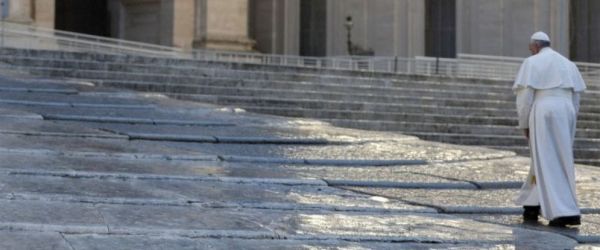[…] we return to Jerusalem, in the Upper Room, as though guided by the two disciples of Emmaus, who had listened with great emotion to Jesus’ words along the way and then had recognized him “in the breaking of the bread” (Lk 24:35). Now, in the Upper Room, the Risen Christ presents himself in the midst of the group of disciples and greets them: “Peace to you!” (v. 36). But they are frightened and believe “that they saw a spirit” (v. 37), the Gospel says. Jesus then shows them the wounds on his body and says: “See my hands and my feet” — the wounds — “that it is I myself; handle me” (v. 39). And to convince them, he asks for food and eats it before their astonished eyes (cf. vv. 41-42).
There is a detail here, in this description. The Gospel says that the Apostles “still disbelieved for joy”. The joy they felt was such that they could not believe that this was true. And a second detail: they were bewildered, astonished; astonished because the encounter with God always leads you to astonishment: it goes beyond enthusiasm, beyond joy; it is another experience. And they were joyful, but a joy that made them think: no, this cannot be true!... It is the astonishment of God’s presence. Do not forget this frame of mind, which is so beautiful.
Three very concrete verbs characterize this Gospel passage. In a certain sense, they reflect our individual and community life: to look, to touch and to eat. Three actions that can give joy from a true encounter with the living Jesus.
To look. “See my hands and my feet”, Jesus says. To look is not only to see, it is more; it also involves intention, will. For this reason, it is one of the verbs of love. A mother and father look at their child; lovers gaze at each other; a good doctor looks at the patient carefully... Looking is a first step against indifference, against the temptation to look the other way before the difficulties and sufferings of others. To look. Do I see or look at Jesus?
The second verb is to touch. By inviting the disciples to touch him, to verify that he is not a ghost — touch me! — Jesus indicates to them and to us that the relationship with him and with our brothers and sisters cannot remain “at a distance”. Christianity does not exist at a distance; Christianity does not exist only at the level of looking. Love requires looking and it also requires closeness; it requires contact, the sharing of life. The Good Samaritan did not limit himself to looking at that man whom he found half dead along the road: he stopped, he bent down, he treated his wounds, he touched him, he loaded him onto his mount and took him to the inn. And it is the same with Jesus himself: loving him means entering into a communion of life, a communion with him.
And thus, we come to the third verb, to eat, which clearly expresses our humanity in its most natural poverty, that is, our need to nourish ourselves in order to live. But eating, when we do so together, among family or friends, also becomes an expression of love, an expression of communion, of celebration... How often the Gospels present us with Jesus experiencing this convivial dimension! Even as the Risen One, with his disciples. To the point that the Eucharistic Banquet has become the emblematic sign of the Christian community. Eating together the Body of Christ: this is the core of Christian life.
Brothers and sisters, this Gospel passage tells us that Jesus is not a “ghost”, but a living Person; that when Jesus draws near to us he fills us with joy, to the point of disbelief, and he leaves us bewildered, with that astonishment that only God’s presence gives, because Jesus is a living Person.
Being Christian is not first of all a doctrine or a moral ideal; it is a living relationship with him, with the Risen Lord: we look at him, we touch him, we are nourished by him and, transformed by his Love, we look at, touch and nourish others as brothers and sisters. May the Virgin Mary help us to live this experience of grace.
[Pope Francis, Angelus 18 April 2021]












